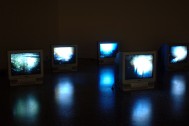waiting to take the picture
2009, by Hoegen&Stikker
Size variable, durations differ
Installation view:
Exhibition Inscription, Philippine Hoegen & Carolien Stikker
19-09 to 29-11 2009
SamuelDorskyMuseumof Art, NewPaltz,New York
"...There is, however, an optical méconnaissance, as the eye, recognising change in luminosity as a change in form, gives unconscious credence to an investment in the fidelity of cinema’s flickering sensibilia. We react to a moving image, the trace of a person, for example, as if he or she were present. In a similar fashion, we presume the deferred presence of somebody as having been, at some time, present before the camera such that it (the device, unintentionally)— or someone else behind the camera (intentionally)— has observed and faithfully secured the image of the person or event represented. But the camera itself does not see4; it has been prosthetically inserted between the original subject and the (intending) eye of the person operating the camera, so that it circumscribes and subsumes the space of the spectator, a ‘camera-eye’ which holds place for—simulates—the presence of the eye of the spectator, such that there is a presumed and coextensive identification between the apparatus, the originary operator, and the present spectator, which serves as an evidentiary trace of photographic verisimilitude, a technically reproducible access to the real. It is an instance of the camera’s penetration into human re/cognition, inducing us to proceed as if the shadows before us have some privileged link to a present that has not passed away, but which, once having taken place—arrested in the trace of the image—is present at every moment, and moreover persists, holding place for the potential recuperation of the real. Cinema is, in this sense, always promissory: there is a strange prolepsis concerning technical reproducibility, a presumption that the repetition of the real constitutes a privileged access to the originary act or event— a strange conceit that locates the deferred and absent trace in some recoverable elsewhere.
It is at this juncture that, through a strategy both simple and profound, Carolien Stikker and Philippine Hoegen interrupt and problematize the consumption of images: the surface/screen of the image is continuously marked with an elegant and minimal deictic5 device, a registration mark or 'crosshair' that occupies the center of the screen, a constant reminder that 'you are here'—at the surface."
Thomas Zummer, Interstices, 2009















